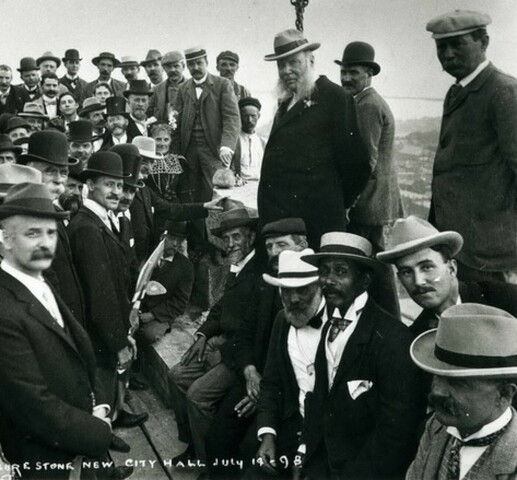
Unveiling Heroes: William Hubbard
William Peyton Hubbard
City officials atop Old City Hall, July 14, 1898. Image by Josiah Bruce. Courtesy of the City of Toronto Archives, Fonds 1268, Series 1317, Item 216.
Old City Hall decorated for the inauguration of the Toronto Hydro-Electric System, May 2, 1911.
Obituary for William Peyton Hubbard, Toronto Star, April 30, 1935.
Portrait of William Peyton Hubbard, 2022. Image by Autumn Beals.
Toronto born
William Peyton Hubbard was born in 1842 near the intersection of Bathurst and Bloor. Hubbard’s parents, Mosely and Lavenia, had escaped enslavement in Virginia via the Underground Railroad, settling in Toronto in 1840. Hubbard was born into a Toronto which, despite not being officially segregated, maintained a strong colour bar with barriers to housing and limited work opportunities for the Black community. At the time Hubbard was born, Toronto’s Black community was approximately 1,000, out of a total city population of 40,000.
Hubbard’s father, Mosely, worked several jobs to pay for his son’s education at the Toronto Model School. While most students at the Toronto Model School became teachers, Hubbard became a baker, specializing in pastry. After 16 years in baking, Hubbard changed careers and began driving cabs for a relative’s stable company. By 1878, Hubbard had his own livery stables at 59 Bathurst Street.
Toronto’s first Black alderman
While working as a livery driver, Hubbard developed a friendship with newspaperman and abolitionist George Brown, who encouraged Hubbard to run for political office. In 1894, Hubbard was elected city alderman, becoming the first Black person to be elected to public office in Toronto.
Hubbard was an intelligent and well-spoken politician, with the nickname ‘the Cicero of the Council.’ Hubbard was known for well-researched and passionate speeches condemning corruption of government officials and advocating for publicly owned services. In 1898, Hubbard was appointed to the Board of Control which advised the mayor and council on municipal spending. Over the course of his career, Hubbard was elected to public office 15 times.
Experiences of racism
Hubbard served as an advocate and voice for marginalized and overlooked communities in Toronto. He supported the establishment of Houses of Industry, shelters for those experiencing poverty, before gaining public office. He also defended both Toronto’s Chinese and Jewish communities, who were often targeted and subject to discrimination and violence.
Despite his position, Hubbard was not immune to racial prejudice. Hubbard suffered abuse by city councillors from other cities and was often required to carry character reference letters from the mayor when conducting business outside the city to confirm his identity as alderman.
Lighting up Toronto
One of Hubbard’s lasting legacies was the establishment of a public electricity grid in Toronto. In the early 20th century, electricity in the home was a luxury many Torontonians could not afford. Alongside Adam Beck, Hubbard helped to establish the provincial Hydro-Electric Power Commission (now Hydro One) before securing legislation establishing a city-wide public power grid.
This important work ensured affordable city-wide power, but it briefly cost Hubbard his public office. In his campaign for electricity, Hubbard lost the support of many wealthy business owners who were against the Commission. Hubbard was re-elected in 1913 before retiring later that year to care for his ill wife, Julia. Upon his retirement, Hubbard was celebrated with an official portrait in (Old) City Hall. Hubbard died in 1935 after a brief illness. In honour of his contributions to Toronto, flags on all public city buildings were flown at half mast the day he died.
Master of the elements
As part of BSAM Canada’s “Unveiling Heroes of the Block” project, artist Autumn Beals’ portrait of William Peyton Hubbard, entitled “Master of the Elements,” emphasizes his multi-faceted career, and the way in which his life’s work was connected to numerous spaces of Toronto.
Her use of colours reminds the viewer of his participation in the creation of a hydro-electric system (represented in blue), his experience as a baker (orange); his life as an intellectual and inventor (purple); and his advocacy for equal opportunities for marginalized communities (green). Surrounding all of these elements is black ether to represent an interconnectedness between these aspects of Hubbard’s life.

